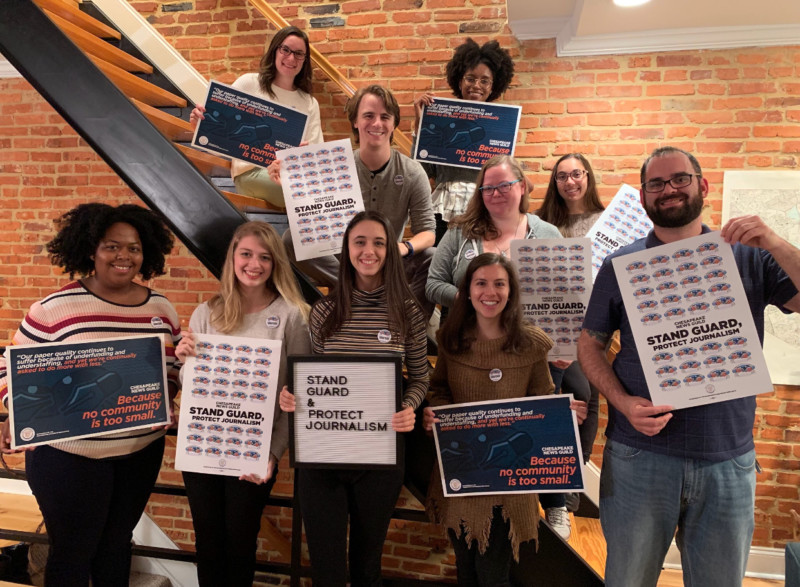Sign up for the daily CJR newsletter.
Jon Kelvey is 37 years old. He works at the Carroll County Times, a small daily newspaper owned by Tribune Publishing Company, based in Westminster, Maryland. Kelvey, a reporter since 2012, has a wife and a young daughter, and is the family’s sole breadwinner. His annual salary is $36,500, a figure Kelvey estimates makes him the highest-paid writer in the newsroom. But the difference between his wage and the cost of living means Kelvey must still use the same community food banks that he has often been called on to write about.
I’ll add that as a full time reporter AND full time freelancer, I frequently patronize two area food banks I have also, at times, had to cover (I’m typing this from the waiting room of one in fact). That’s a mild conflict of interest that could be avoided by a living wage. https://t.co/rObGzl3TXM
— Jon kelvey – jonkelvey.bsky.social (@JonKelvey) June 4, 2019
Kelvey, a member of the Chesapeake News Guild, is one of many Maryland-based reporters rallying for more pay from Tribune Publishing, which recently announced a $56 million payout for its shareholders. Other members of the Chesapeake News Guild—whose newsrooms include the Times, papers in the Baltimore Sun Media Group, and the Annapolis-based Capital Gazette, where five staffers were killed by a gunman last year—have shared their financial struggles online. Some are looking for supplemental work that fits with a reporter’s erratic schedule; others lament hourly pay that amounts to less than $15.
“We are tired of not receiving reasonable cost of living raises, despite the fact we bear the additional responsibilities of our former co-workers,” the guild announced. Its Twitter account, @ChesapeakeGuild, also sent Kelvey’s tweet to Tribune Publishing’s account: “Hey @tribpub, are you embarrassed that you have full-time reporters who regularly go to food banks? You should be.”

Chesapeake News Guild members (front row, left to right) Erin Logan, Libby Solomon, Danielle Ohl, Jess Nocera, Jack Chavez; (back row, left to right) Megan Woodward, Cody Boteler, Lauren Lumpkin, Erin Hard (since promoted to management), and Selene San Felice.
Informal unionization talks began in 2017, and took shape with guidance from members of the Baltimore Sun’s union. Tribune recognized the union last December, a step towards contract negotiations guild members hope will include a living wage and greater influence on what happens in their newsrooms. (Tribune did not respond to a request for comment from CJR.)
Meanwhile, guild members share stories like Kelvey’s, to vent, to keep spirits up, and to keep spreading the word. “We all love the place where we work,” Ohl says. “We want the newspaper that we’ve grown to really cherish to be a place where people can see themselves making a career.”
ICYMI: Edit tests are out of control, say journalists in search of jobs
Cody Boteler, who reports for the Baltimore Sun Media Group and is involved in the guild, tells CJR he makes $30,000 per year. “It doesn’t embarrass me because I know what I signed up for and my value as a human is not determined by the value of my paycheck,” he says. Once Tribune recognized the guild, Boteler says, he felt more comfortable voicing frustrations with wages and pushing back against decisions he disagreed with.
A few years ago, Kelvey says, he used the MIT living wage calculator to find the average living wage for a family of two adults and one child living in Carroll County, Maryland. The total? About $46,000 a year. He’s received a few small salary increases—a one-percent raise given to all Tribune employees in 2016, a “more substantial” raise after that, and another small bump when he was offered a job elsewhere. Still, his annual salary falls more than $9,000 short of the living wage average.
“And that’s assuming the average living wage,” he says. His wife and daughter have celiac disease, which can make for a costly grocery budget as sufferers must avoid gluten. Kelvey goes to the food bank every Tuesday to buy things such as eggs and ground beef. “Talk about cutting out avocado toast is kind of infuriating because it’s very far from my world,” he says.
Kelvey worries that low pay will negatively impact the Carroll County Times’ ability to maintain newsroom staff. As it is, the newsroom is working at a deficit. Before Tribune purchased the Times in 2014, there were seven reporters in the newsroom, a number considered to be a full complement; currently, there are five editorial staffers, including an intern.
“None of us at the Carroll County Times are asking to become wealthy being reporters at a local newspaper,” Kelvey says. “We’d just like to be able to pay our bills.”
The Media Today: Jeffrey Epstein’s arrest puts a Miami Herald story back in the spotlight
This post has been updated to clarify the state of the guild’s negotiations with Tribune Publishing.
Has America ever needed a media defender more than now? Help us by joining CJR today.







